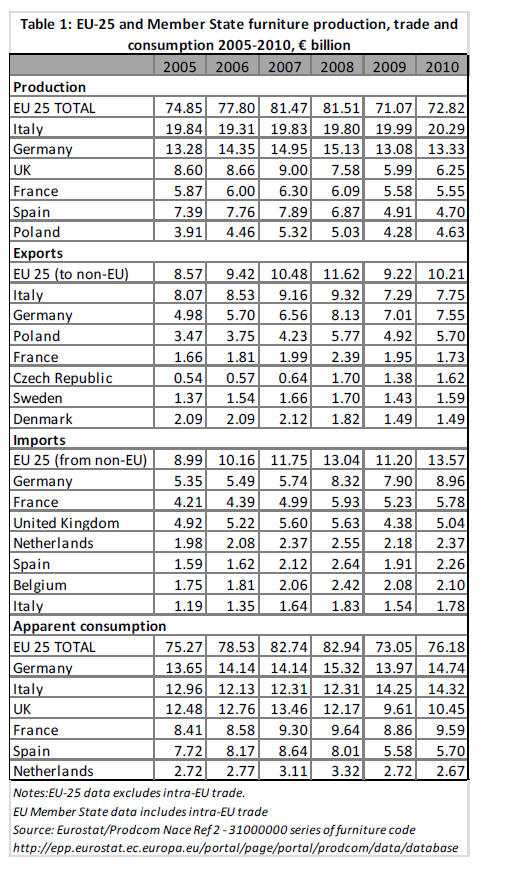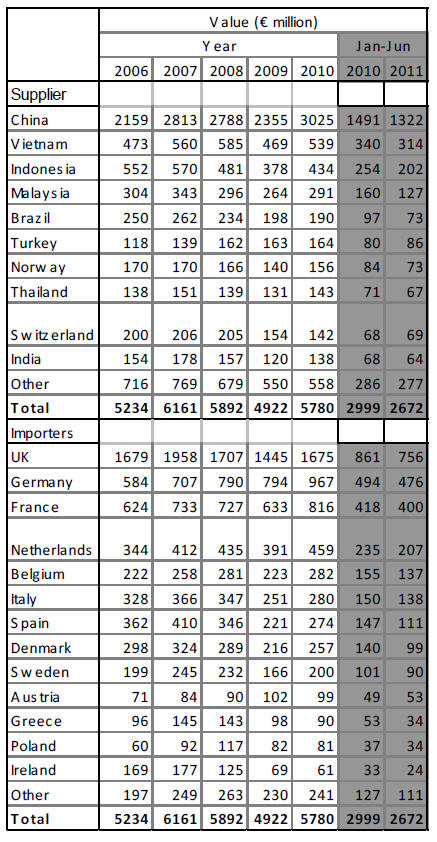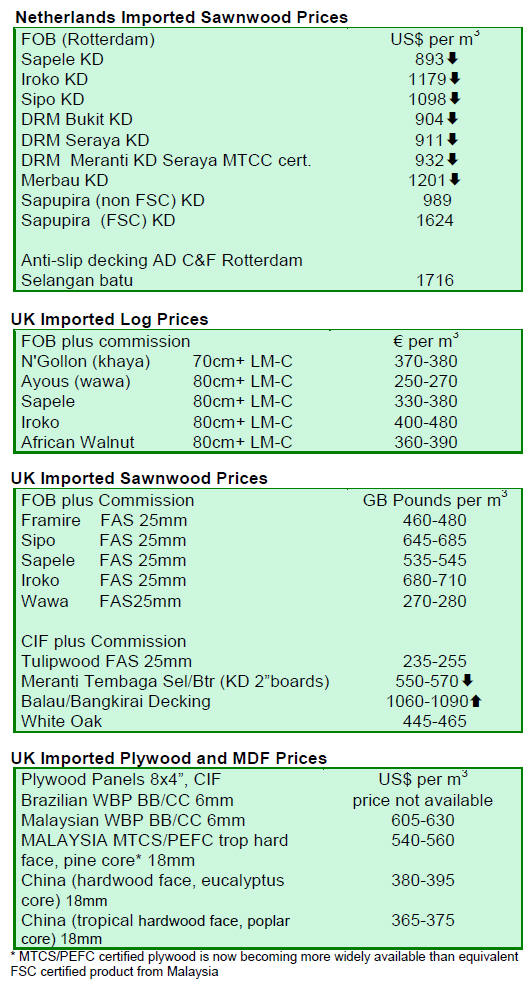|
Report
from
Europe
Slow buying of bangkarai decking in Europe
According to the latest issue of EUWID, the Germanybased
wood trade journal , central European importers
were holding relatively high stocks of bangkirai decking at
the end of the 2011 summer season and have therefore
been off-loading these at below replacement value.
This situation has arisen partly due to shipment delays
which led to significant volumes of bangkirai decking
scheduled for June arrival not reaching Europe until
October or even early November. Economic uncertainty
combined with the existing surplus has dampened interest
in new orders for the 2012 season.
EUWID also reports that CIF euro prices for Malaysian
meranti window scantlings have been rising throughout
2011 and are now 20-25% higher than the start of the year.
This is due to the rise in the dollar value against the euro
combined with limited supplies of roundwood in South
East Asia. Prices are now at such a level that European
manufacturers are actively looking for substitutes.
On the other hand, according to EUWID, the supply
situation is less tense for meranti lumber with currently
available supplies still higher than existing weak demand.
Falling freight rates and slightly lower FOB US$ prices
offered by Malaysian exporters have helped to offset the
impact of the weakening euro to keep CIF euro prices
relatively level for European importers.
European furniture consumption weakening in 2011
after rising in 2010
Last year, the value of EU furniture consumption
increased 4% to €76.2 billion, supporting a 2% increase in
production and a 21% increase in imports from countries
outside the EU. However signs are that furniture
consumption is slipping back again during 2011 as
economic uncertainty has mounted.
European manufacturers and brands continue to dominate
the European furniture market. Last year, European
furniture production was valued at €72.82 billion and
domestic manufacturers accounted for well over 80% of
the value of products supplied to the EU.
This partly reflects strong consumer loyalty to European
brands in some EU countries, combined with strong
technical, design and marketing skills, particularly
prominent in the major German and Italian furniture
sectors. Together these two countries account for nearly
half of all furniture produced in the EU.
Another factor limiting market opportunities for furniture
suppliers outside the EU is fragmentation of retailing
activities in many European countries. This greatly
complicates the process of identifying buyers and
marketing products.

Domestic furniture manufacturers also benefit from their
natural proximity to consumers, a factor which, if
anything, has become more significant in these times of
tight stock control and just-in-time trading.
Proximity to the customer is particularly important in
Europe¡¯s large contract furniture sector involving supply
of bespoke products and services, mainly to the hospitality
sector (hotels, restaurants and bars) but also to the office,
health, education, airport, and marine sectors.
The contract sector accounts for a very significant share of
all furniture demand in most European countries. In the
UK for example the contract sector is believed to account
for 30% of furniture sales.
Despite these obstacles, the value of furniture imports into
the EU from outside the region increased by 21% last year
to reach €13.57 billion, with particularly strong growth in
imports from China, Vietnam, Indonesia, and Malaysia.
EU imports of wood furniture rebounded strongly in 2010
The following table provides more detailed information on
recent trends in EU imports of wood furniture from
outside the region.
It highlights that after the significant decline in the value
of imports in 2009, imports of wood furniture rebounded
strongly by 17% in 2010 to reach nearly €5.8 billion.
EU wood furniture imports rose strongly last year from
China (+28%), Vietnam (+15%), Indonesia (+15%),
Malaysia (+10%), Thailand (+10%) and India (+15%).
This strong rebound in imports was evident in all the
major EU consuming countries including the UK,
Germany, France, Netherlands, Belgium, Italy and Spain.
EU 25 Furniture Imports.
¡¡

However, as austerity has begun to bite and other signs of
economic strain have emerged in Europe during 2011, EU
imports of wood furniture have weakened again in 2011.
In the first 6 months of the year, the value of imports fell
by 11%.
Imports were down from all the major supply countries
including China (-11%), Vietnam (-8%), Indonesia (-
20%), Malaysia (-21%) and Brazil (-24%). As with the
upturn, the downturn has been almost universal across all
EU Member States.
Unfortunately the trade data does not allow for any
reliable separation of furniture into exterior and interior
products. In the past, tropical countries have dominated
markets for weather-resistant exterior furniture products,
while temperate countries have dominated markets for
interior furniture products where diversity of look and
grain is more important.
This simple division has been breaking down rapidly.
Tropical countries like Vietnam, Indonesia and Malaysia
have increasingly diversified into interior furniture
products. This trend has been driven by a combination of
tightening supply and rising prices for tropical hardwoods
and the competitiveness of South East Asian countries
able to draw on relatively low labour costs and traditional
wood-working skills.
Originally, most interior products supplied to Europe by
South East Asian countries were based on local plantation
timbers, notably rubberwood. However, these countries
are now importing increasing volumes of temperate
hardwoods, from both Europe and the United States, for
manufacture and re-export of interior furniture.
Product innovation increases pressure on tropical
hardwood garden furniture
The growing expense and rarity of good quality tropical
hardwoods suitable for exterior furniture, combined with
the environmental concerns of European retailers and
innovations in other material sectors, has meant tropical
hardwoods have continued to lose share in the European
garden furniture sector.
This is well illustrated by a recent report on new trends in
European garden furniture contained in the latest issue of
World Furniture published by CSIL, the Italian furniture
research organisation
(http://www.worldfurnitureonline.com/).
There is no mention of tropical hardwood in the report
which instead focuses heavily on new High Density
Polyethylene (HDPE) fibres which allow manufacturers to
design furniture suitable for all weather use. This synthetic
rattan is typically woven onto a lightweight metal
structural frame and is available in a multitude of colours
and weaving patterns.
The article claims that HDPE is non-toxic and recyclable
and that it also offers high Grey Scale ratings (low rate of
colour loss due to weather exposure).
The article also highlights the development of new
products based on ¡°recycled and recyclable¡± materials, for
example combining hemp fibre, specially treated against
UV radiation, with stainless steel tubing which is
¡°electrolytically polished¡± to remove surface ferrous
particles and ensure increased resistance to atmospheric
corrosion.
These products may be designed to ensure that all
components can be fully disassembled, thus simplifying
the recycling process and helping to reduce the
environmental impact.
While it may be little consolation to wood producers,
many of these products supplied into Europe are also now
manufactured in South East Asia.
Large retailers increasingly dominate the UK furniture sector
The latest edition of CSIL¡¯s World Furniture magazine
provides commentary on other key trends impacting on
Europe¡¯s furniture sector. A special article on the UK
furniture retailing sector highlights that major structural
changes are underway.
While the UK imports large volumes of furniture from
Germany, Italy and Poland, relatively high levels of
consolidation in the retail sector has been a major factor
behind the UK¡¯s emergence as by far the largest importer
of furniture from countries outside the EU, particularly
China but also including Vietnam, Indonesia and
Malaysia.
World Furniture reports that UK imports from Germany
and Italy have generally been declining in recent years,
while imports from China, South East Asia and Poland
have tended to rise.
According to World Furniture, the UK market remains
tough with little or no growth this year. 2011 has seen
some significant bankruptcies in the furniture retailing
sector.
In May 2011, the Focus DIY group, with 178 stores and a
turnover of €524 million has been the largest retail
bankruptcy in the UK this year. It was closely followed in
June by national furniture retailer Habitat which operated
a network of 30 stores around the country.
Most recently, the Homeform Group has also gone into
administration, and is trying to sell its Moben and Dolphin
brands in an effort to save its Sharps and Kitchens Direct
businesses.
The structure of the UK furniture sector is now shifting,
says World Furniture. Smaller independent furniture
retailers have suffered the most during the recession, while
larger retailers have continued to increase their
dominance.
This includes department stores led by Home Retail
Group, Marks & Spencer and The John Lewis Partnership,
furniture retailer chains like IKEA and Furniture Village,
together with kitchen specialists like Magnet, Harvey
Jones and Moben, and upholstery specialists like DFS and
Reid Furniture. Buying groups are also becoming
increasingly important in the market.
Large DIY retailers like B&Q and Wickes, more
concentrated now following the collapse of Focus, are also
playing a more important role in the market, particularly at
the bottom end and in the garden furniture segment.
However, according to World Furniture, the fastest
growing segment is mail order business, much of which is
controlled by existing dominant retailer brands through
their new direct sales divisions.
German furniture demand remains buoyant
The latest edition of World Furniture also highlights that
Germany has been one of the few bright spots in Europe¡¯s
furniture sector this year. Furniture production is expected
to be up 5% overall in Germany this year, with particularly
large increases in office furniture production (+22.8%) and
shop fitting (14.9%).
Most other sectors are forecast to record production
growth of between 4% and 6% this year, with only the
upholstered furniture sector giving any cause for concern.
German import and export flows are also expected to
remain positive for 2011 as a whole.
Interaction between European and Chinese furniture sectors
Today, no review of the furniture sector in any part of the
world would be complete without mentioning China. An
interesting dynamic is emerging between China, the
world¡¯s largest furniture producer and exporter, and
Europe which still plays host to the world¡¯s largest and
most innovative furniture design community and most
desirable furniture brands.
In the early days of China¡¯s efforts to penetrate the
European furniture sector, manufacturers were seemingly
content to focus on a volume-driven rather than a productand-
design-driven industrial strategy.
The early emphasis was on contract manufacturing,
mainly at the lower end of the market, rather than on ownbrand
furniture manufacturing. However, there has been
growing recognition amongst Chinese manufacturers that
this will lead to progressive loss of competitiveness as the
barriers to entry in contract manufacturing are relatively
low and there will always be opportunities for
manufacturers in lower-cost locations to take market
share.
Therefore, as labour and other costs in China have been
gradually rising, the future growth of the Chinese furniture
industry is closely tied to its penetration of the middle
range. According to World Furniture, this is now
beginning to happen.
Many of China¡¯s leading firms (Kuka for upholstered
furniture, Matsu for office furniture, Oppein for kitchens)
today use a combination of Chinese, Asian and European
designers for their own production. They are also
introducing first class technologies into all the major
furniture districts.
Another factor affecting the dynamic between European
and Chinese firms is the beginnings of a ¡°reversal in
trade¡±. No longer is it just about Chinese furniture firms
increasing penetration of the European market. It is also
about European firms taking a share of the potentially vast
opportunities emerging in China¡¯s domestic market.
The recent appreciation of the Remimbi (from a rate of 10
to the Euro, to the current 8.5) is beginning to make
Chinese exports more difficult and imports more
accessible. Rising income and emergence of a new middle
class of consumers means that China is becoming more
interesting for European furniture players.
According to World Furniture, German and Italian
producers of high-quality brand-name furniture are
becoming more engaged in selling to China. They now
face the difficult choice between exporting to China and
producing locally.
Some firms have failed in their attempt to produce locally
(e.g. Decoro) or have chosen to sell to third parties
(Faram). Others have been more successful, for example
Natuzzi has become one the best-selling brands in China,
while Colombini which specialises in children¡¯s furniture
now has almost 100 sales outlets in China.
Russia to accede to the WTO in 2012
The World Trade Organization finalised terms for Russia's
membership in early November, which should enable it to
gain final approval from WTO trade ministers at a meeting
in December and to join the body early next year.
To gain admittance, Russia had to bring its own laws into
line with WTO rules and satisfy the 153 existing members
that it is committed to enforcing WTO standards.
The accession agreement states that the tariff ceiling for
imports of wood and paper products into Russia will be
reduced from the current level of 13.4% to 8%. In the
long term, this is expected to provide new opportunities
for suppliers in other countries to develop sales in Russia.
However, a more immediate and dramatic effect of WTO
accession may be to liberalise Russia¡¯s log exports. Russia
was formerly a key source of raw logs, mainly softwood,
to the international market.
This changed when Russia increased its wood export
duties in 2006 from 2.5 euros ($3.3) per cubic meter,
reaching 15 euros in 2008.
Russia¡¯s log exports fell from 51.1 million m3 in 2006 to
only 21.4 million m3 in 2010. Following Russia¡¯s
accession to WTO, export tariffs are expected to be
progressively cut on birch and aspen logs by 75% and on
spruce and pine logs by 50%.
In the European market, this move is expected to have a
particularly dramatic effect on log supply to the pulp and
paper sector in Scandinavia. Scandinavian companies
imported around 12.3 million cubic meters of Russian logs
in 2008, but with imposition of the export tariffs these
imports halved the following year and stood at 7.3 million
cubic meters in 2010.
This had a particularly profound effect on the Finnish
industry which subsequently announced closures of 10
paper and pulp mills and reduced overall production by
nearly a fifth in 2007-10.
Russia's accession to the WTO will open the door once
again to EU log imports from Russia. However, due to the
closure of some Scandinavian mills previously dependent
on the supply, and the development of alternative sourcing
strategies by remaining mills, there is little expectation
that European imports will ever return to previous levels.

Related News:
|